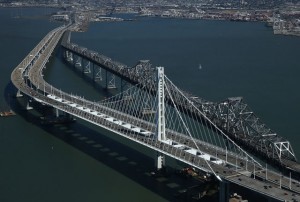The groundbreaking ceremony for the just-opened Expo Line light rail to Santa Monica took place back on September 29, 2006. I was there and got this cool mini shovel memorabilia to honor the occasion:
That means that the opening of the full line to Santa Monica on Friday happened just under 10 years after groundbreaking. For those keeping score at home, that means the Expo Line Construction Authority managed to build 1.5 miles of rail each year.
As far as rail lines go, this should not have been a very complicated construction job. The line runs virtually entirely at-grade, with minimal trenching and a handfull of overpasses. In addition, the right-of-way already existed and therefore required relatively little property acquisition and condemnation.
In short, the amount of time spent to build this line seems absurd. That’s not even counting the years of planning. And yet the region’s leaders apparently aren’t upset by it or demand any better.
Sadly, at this point, Californians have just gotten used to these interminable construction timetables. High speed rail is way behind schedule and won’t open until probably the 2040s or 2050s, if at all. The Purple Line subway extension down Wilshire most likely won’t be operational until the 2030s. Even automobile projects like the San Francisco Bay Bridge eastern span took over a decade to open.
It’s a subject I tackled for UCLA Law in 2014, with the report Back in the Fast Lane, and an op-ed in the San Francisco Chronicle. Yet I’ve seen little interest among policy makers (or even the public) to tackle this issue. Why the complacency?
For those who care about boosting transit, they have an interest in getting ahead of this problem. A few bad headlines can undermine political support for transit investments, especially in California where advocates need two-thirds voter approval for tax measures. And it also means we’re getting much less bang for our buck on these projects, which means fewer projects that benefit people.
It’s enough to make me mad. Or maybe it will later. At some point anyway.
I’m all in favor of a good takedown of poor public sector decision-making. But Jaxon Van Derbeken’s attempt in the San Francisco Chronicle’s Sunday edition to criticize the Bay Bridge design selection back in 1998 is pretty weak.
Van Derbeken’s thesis (although of course he doesn’t come out and say it) is that the bridge selection committee was stacked with a bunch of non-bridge experts who, because of their ignorance and arrogance, picked the wrong design, thereby resulting in huge cost overruns and construction defects:
They were elite architects, engineers, seismologists and academics — but few had any experience building or designing bridges. After a yearlong process, 19 of them gathered in an auditorium in Oakland to choose between two alternatives: a conventional span resembling more than 100 bridges worldwide, and a daring design that had never been tried on such a scale.
But the problem is that these decision-makers appear to have been badly misled by a flawed staff report:
Both [bridge design options] would cost roughly $1.5 billion, the group was told, although the attention-grabbing span was the more expensive of the two — perhaps as much as $173 million more for a bridge that would look like no other.
“At the time, it seemed a meaningless difference” and an amount “well worth spending,” said panel member Jeffrey Heller, a high-rise architect.
It turned out, however, that the difference was much more. The final sum may not be known for decades, until the problems that cascaded from the panel’s approval of a self-anchored suspension span in 1998 — broken rods, leaks in the steel structure, cracked welds, misaligned road decks — are fixed with toll payers’ dollars.
Van Derbeken never investigates who wrote the report or why they got the cost predictions so terribly wrong. The cost difference as presented to the decision-makers seemed relatively minimal in the grand scheme of things. So why not go with a nicer-looking option? Plus, a later decision to move the bridge’s lone tower closer to Yerba Buena Island, driven in part by aesthetic considerations but also seismic concerns, made the cheaper option less viable, if not unworkable.
Van Derbeken should have singled out the agency personnel for blame here. Now perhaps a more educated group might have pushed back on the staff report, but there’s no indication that even the opponents of the ultimate design choice urged a new staff report. At a minimum, Van Derbeken should have investigated.
But perhaps even worse, Van Derbeken fails to link the construction defects that occurred as a direct result of the bridge design. Instead, all the defects point to shoddy workmanship that could have happened with any design:
A batch of galvanized rods needed for extra seismic strength on the unusual bridge cracked, adding more than $45 million in costs. A Chinese crane maker won the money-saving contract to make pieces of the bridge, but turned out shoddy welds and produced ill-fitting road decks at risk of premature cracking.
Connecting the self-anchored suspension span to the skyway portion of the bridge turned out to be what [MTC head Steve] Heminger called “the fabrication challenge of a lifetime,” slowed down the project by a year and added $145 million to the bill.
Lightweight steel guardrails were used instead of the usual concrete on the suspension span; holes, drilled in the deck so the barriers can be attached to the bridge, leak when it rains. Rods that hold down the tower became steeped in rainwater and could be at risk of corroding.
Now maybe these defects were more likely to occur given the extra work allegedly required by this design. But Van Derbeken doesn’t make that case explicitly — my guess is because he can’t. None of these defects are excusable, and they point to basic mismanagement and poor construction techniques. But blaming the design doesn’t make sense, at least with the evidence presented here.
My hunch — and I say this without direct knowledge — is that Caltrans may be the real culprit here, from doing a bad job preparing a crucial staff report to overseeing the entire, flawed construction process. Perhaps Van Derbeken should focus his investigation on that agency, instead of trying to make villains out of the design selection team.




